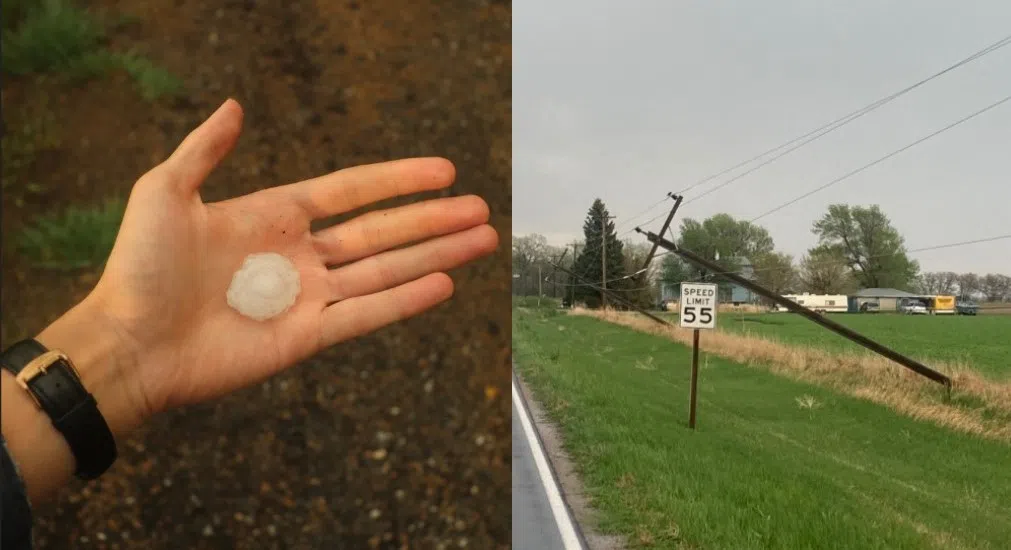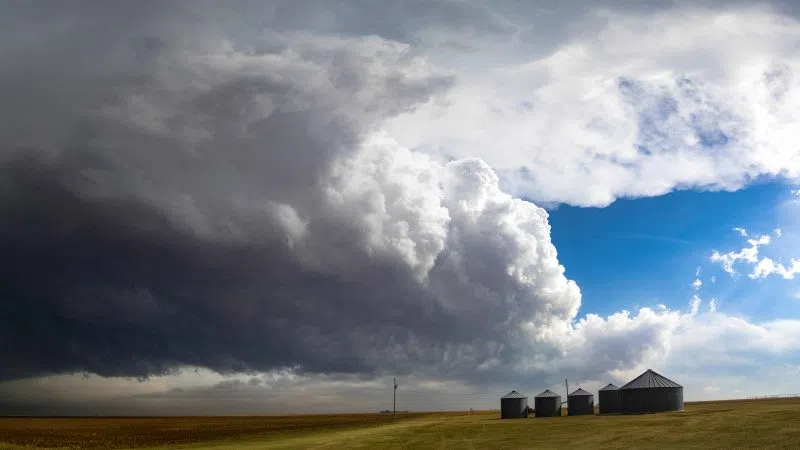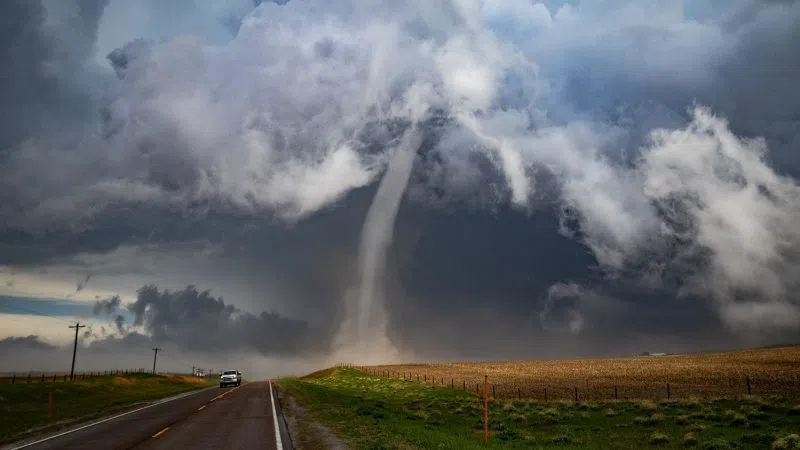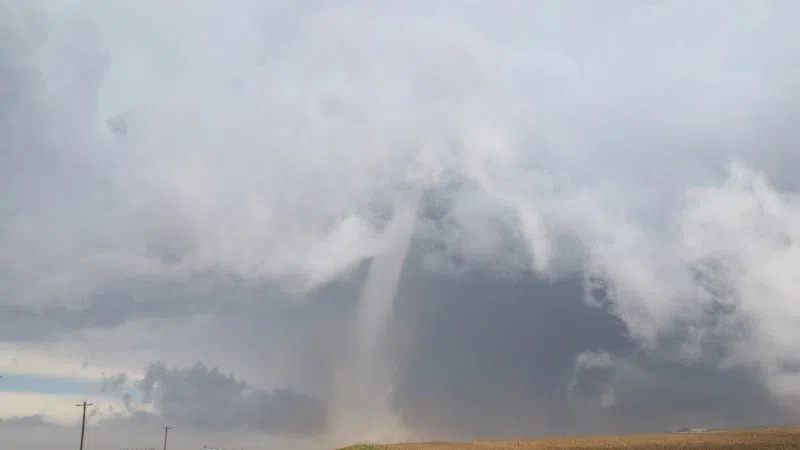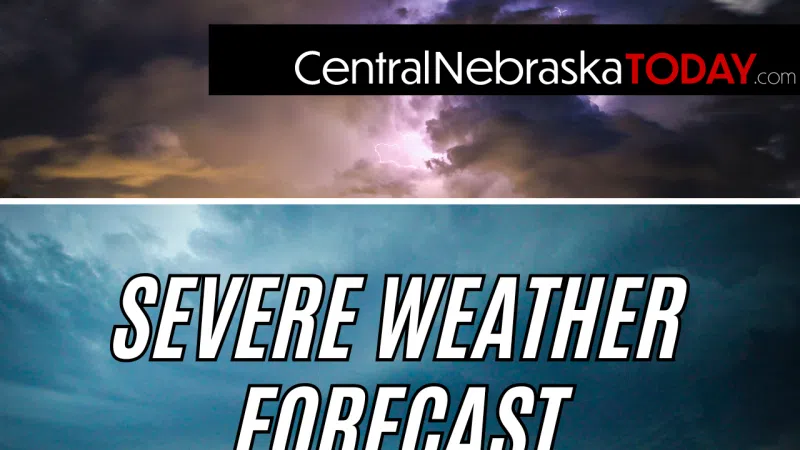HASTINGS — Tornadoes may get all the headlines, but the damaging power of hail and straight-line winds should not be underestimated this severe weather season.
Hail
“Hail is a form of precipitation consisting of solid ice that forms inside thunderstorm updrafts. Hail can damage aircraft, homes and cars, and can be deadly to livestock and people,” according to the National Severe Storms Laboratory, (NSSL).
Hail forms when raindrops are carried upward by thunderstorm updrafts into extremely cold areas of the atmosphere and then freeze together. Hail stones collide with the liquid water droplets and freeze onto the surface.
“If the water freezes instantaneously when colliding with the hailstone, cloudy ice will form as air bubbles will be trapped in the newly formed ice. However, if the water freezes slowly, the air bubbles can escape, and the new ice will be clear. The hail falls when the thunderstorm’s updraft can no longer support the weight of the hailstone, which can occur if the stone becomes large enough or the updraft weakens,” per the NSSL.
The process of hailstone growth is complicated.
“The conditions experienced by the hailstone can change as it passes horizontally across or near an updraft. The layers, however, do not occur simply due to the hailstone going through up and down cycles inside a thunderstorm,” the NSSL states.
“The winds inside a thunderstorm aren’t simply up and down; horizontal winds exist from either a rotating updraft, like in supercell thunderstorms, or from the surrounding environment’s horizontal winds. Hailstones also do not grow from being lofted to the top of the thunderstorm,” according to the NSSL.
At the highest altitudes, the air is cold enough, around minus 40 degrees, that all the liquid water will have frozen and hail needs liquid water to grow to an appreciable size.
Hail eventually falls to Earth when it becomes heavy enough to overcome the strength of the thunderstorm’s updraft.
“Smaller hailstones can be blown away from the updraft by horizontal winds, so larger hail typically falls closer to the updraft than smaller hail. If the winds near the surface are strong enough, hail can fall at an angle or even nearly sideways,” per the NSSL.
Wind driven hail can be especially damaging and can tear up siding on houses, break windows, blow into houses, break side windows on cars and cause serious injury or death to people and animals.
The meeting point of Nebraska, Colorado and Wyoming has been called “Hail Alley,” and averages seven to nine hail days per year.
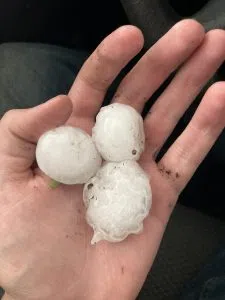
Brian Neben, Courtesy
The largest hailstone recovered in the United States fell near Vivian, S.D., on June 23, 2010. It had a diameter of eight inches, a circumference of 18.62 inches and weighed one pound and 15 ounces.
Most hailstorms are made up of a mix of different sizes, and only the very largest hail stones pose serious risk to people caught in the open.
When reporting hail, estimates comparing the hail to a known object with definite size are good, but measurements using a ruler, calipers, or a tape measure are best.
Storms producing hail one inch or greater are considered severe.
“There is no clear distinction between storms that do and do not produce hailstones. Nearly all severe thunderstorms probably produce hail aloft, though it may melt before reaching the ground,” per the NSSL.
Multi-cell thunderstorms produce many hailstones, but they are not usually very large. In the life cycle of the multi-cell thunderstorm, the mature stage is relatively short so there is not much time for hailstones to grow.
In contrast, supercell thunderstorms have sustained updrafts that support large hail formation by repeatedly lifting the hailstones into the very cold air at the top of the thunderstorm cloud where they can accumulate more layers of ice. In general, hail two inches or larger in diameter is associated with supercells.
It has often been reported that the sky appears green during some hailstorms. This is thought to be due to the fact that the large amounts of water and ice suspended aloft scatter green light and make the clouds appear either green or various shades of blue.
“There have been a handful of hailstorms that resulted in $1 billion or more in damages in the U.S. The costliest storm appears to be that of April 10, 2001, which cut a swath along the I-70 corridor from eastern Kansas to southwestern Illinois and pounded the St. Louis area. Property damage was in excess of $2.5 billion in 2018 dollars,” per Weather Underground’s website.
Damaging Winds
Damage from straight line winds has often been mistaken for tornado damage in the past.
Damaging winds are often called “straight-line” winds to differentiate the damage they cause from tornado damage. Strong thunderstorm winds can come from a number of different processes, per the NSSL.
Most thunderstorm winds that cause damage at the ground are a result of outflow generated by a thunderstorm downdraft. Damaging winds are classified as those exceeding 50-60 mph.
“Damage from severe thunderstorm winds account for half of all severe reports in the lower 48 states and is more common than damage from tornadoes. Wind speeds can reach up to 100 mph and can produce a damage path extending for hundreds of miles,” the NSSL states.
Given that most thunderstorms produce some straight-line winds because of outflow being generated by the downdraft, anyone living in thunderstorm-prone areas are at risk of this hazard.
“People living in mobile homes are especially at risk for injury and death. Even anchored mobile homes can be seriously damaged when winds gust over 80 mph,” per the NSSL.
There are several types of thunderstorms that can produce widespread damaging winds.
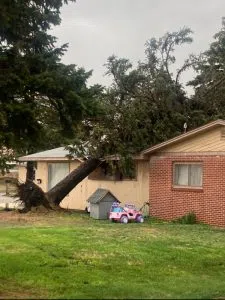
Brian Neben, Courtesy
“A multi-cell storm is a common, garden-variety thunderstorm in which new updrafts form along the leading edge of rain-cooled air, the gust front. Individual cells usually last 30 to 60 minutes, while the system as a whole may last for many hours. Multicell storms may produce hail, strong winds, brief tornadoes, and/or flooding,” per the NSSL.
“A squall line is a group of storms arranged in a line, often accompanied by “squalls” of high wind and heavy rain. Squall lines tend to pass quickly and are less prone to produce tornadoes than are supercells. They can be hundreds of miles long but are typically only 10 or 20 miles wide,” the NSSL states.
“A Mesoscale Convective System (MCS) is a collection of thunderstorms that act as a system. An MCS can spread across an entire state and last more than 12 hours. On radar one of these monsters might appear as a solid line, a broken line, or a cluster of cells,” per the NSSL.
In the most severe cases, a derecho can form.
“It is a widespread, long-lived windstorm that is associated with a band of rapidly moving showers or thunderstorms. Although a derecho can produce destruction similar to that of tornadoes, the damage typically is directed in one direction along a relatively straight swath. As a result, the term “straight-line wind damage” sometimes is used to describe derecho damage,” according to the NSSL.
By definition, if the wind damage extends for more than 240 miles and includes wind gusts of at least 58 mph or greater along the majority of the length, the event may be classified as a derecho.
Derechos gained more press after the infamous August 2020 Midwest derecho which effected eastern Nebraska, Iowa, Illinois, Wisconsin, and Indiana.
Damage was moderate to severe across much of the affected region, but the greatest damage occurred in eastern Iowa and northern Illinois. The greatest winds occurred in Iowa and were measured at 126 mph. Some post damage surveys estimated the highest winds to be 140 mph.
Millions across the Midwest were affected by wide-scale utility disruptions, residential and commercial property damage, and severe damage to corn and soybean crops. Cedar Rapids, Iowa, was the most severely damaged, suffering a near-complete blackout that lasted for weeks in some areas.
The derecho caused over $11 billion in damages and spawned a years-long clean up effort.


